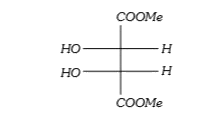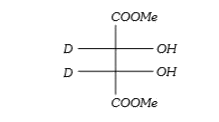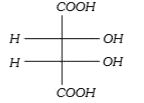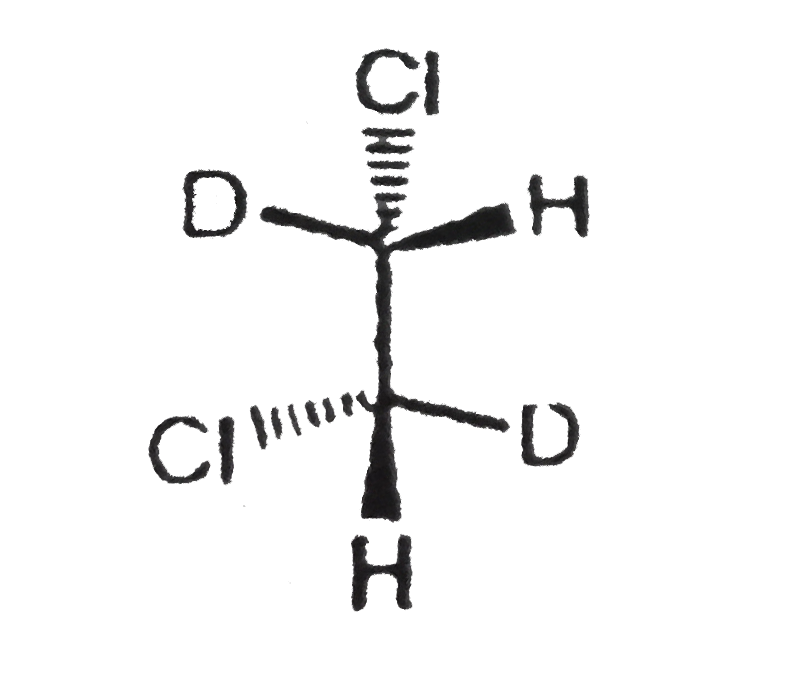The optically active molecule is




The correct Answer is:C
To determine which molecule is optically active, we need to understand the criteria for optical activity. An optically active molecule must be chiral, meaning it has no plane of symmetry (POS) and no center of symmetry (CUS). Here’s a step-by-step solution to identify the optically active molecule:
Step 1: Identify the Molecules
First, we need to look at the given molecules. For this example, let's assume we have three molecules to analyze.
Step 2: Check for Symmetry
For each molecule, we will check for the presence of a plane of symmetry (POS) and a center of symmetry (CUS).
- Molecule 1: Look for any plane that can divide the molecule into two mirror-image halves. If such a plane exists, the molecule is likely not optically active.
- Molecule 2: Repeat the process. If you find a plane of symmetry, this molecule is also not optically active.
- Molecule 3: Check this molecule as well. If there is no plane of symmetry or center of symmetry, this molecule may be optically active.
Step 3: Analyze Chirality
Next, we need to determine if any of the molecules are chiral. A chiral molecule must have four different substituents attached to a carbon atom.
- Molecule 1: If it has a carbon atom with four different groups, it is chiral.
- Molecule 2: Check for chirality as well.
- Molecule 3: If this molecule has a chiral center and no symmetry, it is optically active.
Step 4: Conclusion
After analyzing all three molecules, we conclude which one is optically active based on the absence of symmetry and the presence of chirality.
Final Answer
The optically active molecule is the one that has no plane of symmetry and is chiral.
---
First, we need to look at the given molecules. For this example, let's assume we have three molecules to analyze.
For each molecule, we will check for the presence of a plane of symmetry (POS) and a center of symmetry (CUS).
- Molecule 2: Repeat the process. If you find a plane of symmetry, this molecule is also not optically active.
Next, we need to determine if any of the molecules are chiral. A chiral molecule must have four different substituents attached to a carbon atom.
- Molecule 2: Check for chirality as well.
After analyzing all three molecules, we conclude which one is optically active based on the absence of symmetry and the presence of chirality.
The optically active molecule is the one that has no plane of symmetry and is chiral.
Topper's Solved these Questions
- GENERAL ORGANIC CHEMISTRY BOOK - ERRORLESSCHAPTER - GENERAL ORGANIC CHEMISTRY EXERCISE - PAST YEARS QUESTIONS
85 Videos
- GENERAL ORGANIC CHEMISTRY BOOK - ERRORLESSCHAPTER - GENERAL ORGANIC CHEMISTRY EXERCISE - ASSERTION AND REASON
14 Videos
- GENERAL ORGANIC CHEMISTRY BOOK - ERRORLESSCHAPTER - GENERAL ORGANIC CHEMISTRY EXERCISE - NCERT BASED QUESTIONS (Organic Reactions and their Mechanism )
46 Videos
- ENVIRONMENTAL CHEMISTRYBOOK - ERRORLESSCHAPTER - ENVIRONMENTAL CHEMISTRYEXERCISE - ASSERTION & REASON
7 Videos
- HYDROCARBONSBOOK - ERRORLESSCHAPTER - HYDROCARBONSEXERCISE - ASSERTION & REASON
18 Videos
Similar Questions
Knowledge Check
Which of the following molecule is an optically active molecule?
A2-chlorobutaneB1-propanolC1-butanolD4-hydroxy heptaneOne of the point intresting and useful aspects on stereochemisty is the stuyd of what happens to optically active molecules when they react. The product isolated from the reaction of a chiral starting mterial can tell us a great deal about the reaction mechanism.
In which is inversion of configuration ?AH−C3∣C∣C6H13−BrNal−−−→acetoneBCH3−C2H5∣C∣C3H7−BrNal−−−−−−−−→acetone/waterCH−C2H5∣C∣C3−OH+Cl−O∣∣S−Cl→DH−C3H7∣C∣HC=CH2−OH+H2Pt−−→One of the point intresting and useful aspects on stereochemisty is the stuyd of what happens to optically active molecules when they react. The product isolated from the reaction of a chiral starting mterial can tell us a great deal about the reaction mechanism.
In which reaction there is retention of configuration ?ACH3−H∣C∣D−BrNal/acetone−−−−−−−→BH−C2H5∣C∣CH3−ONa+CH3−I→CH3C−C2H5∣C∣C3H7−Br+HOH→DAll of these
Which of the following are correct for given structure.

(i)Optically active molecule , (ii)Having plane of symmetry , (iii)Having axis of symmetry , (iv)Having centre of symmetry
View SolutionOptically active molecules among the following are
View SolutionThe optically active complex are
View Solutionan optically active compouns is
View SolutionAn optically active compound is
View Solution
